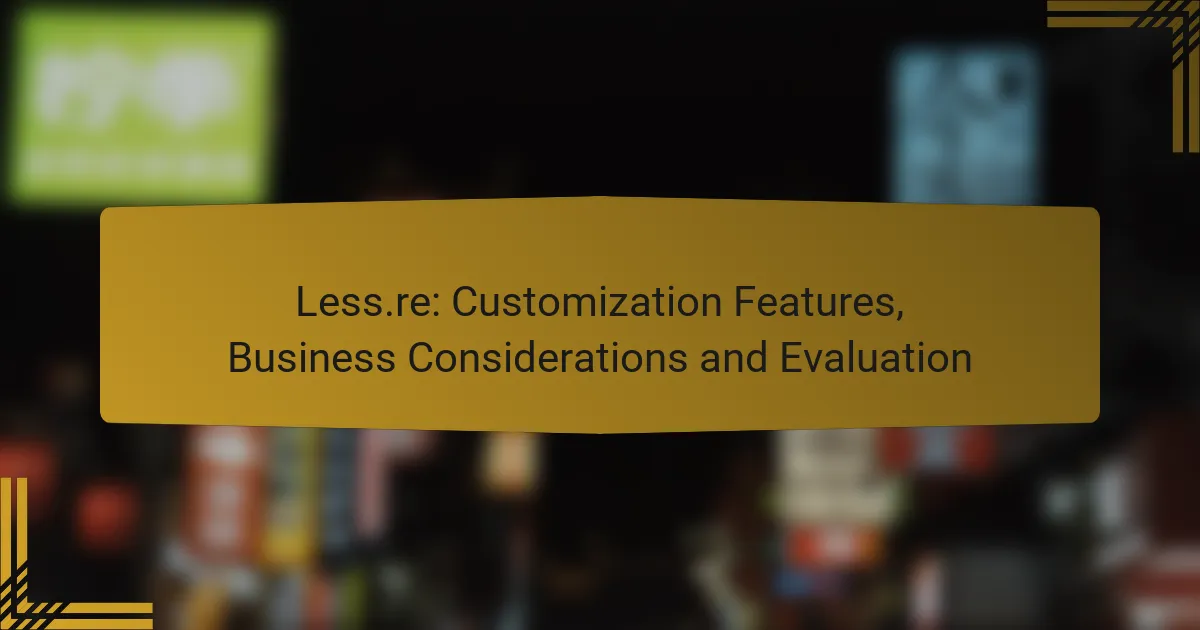Less.re offers a variety of customization features that cater to unique business requirements, enhancing user experience through options like branding, interface adjustments, and workflow automation. By utilizing these capabilities, businesses can improve engagement, streamline operations, and gain valuable insights, ultimately leading to better customer experiences. When evaluating Less.re, it’s essential to consider factors such as cost-effectiveness, scalability, and the support available to ensure a successful implementation.

What customization features does Less.re offer?
Less.re provides a range of customization features designed to enhance user experience and align with specific business needs. These features include branding options, user interface adjustments, integration capabilities, workflow automation, and reporting customization.
Branding options
Less.re allows businesses to incorporate their branding elements, such as logos, color schemes, and typography, into the platform. This helps create a cohesive brand identity across all customer interactions. Companies can typically upload their assets directly through the settings menu.
Consider using high-resolution images for logos and ensuring color contrasts meet accessibility standards. This not only enhances aesthetics but also improves user engagement.
User interface adjustments
The platform offers various user interface adjustments to tailor the experience for different user roles. Users can modify layouts, choose preferred navigation styles, and adjust visibility settings for specific features. This flexibility ensures that each team member can work efficiently.
When making adjustments, prioritize usability by testing changes with actual users to gather feedback. This can help identify any potential confusion or inefficiencies in the modified interface.
Integration capabilities
Less.re supports integration with various third-party applications, enhancing its functionality and streamlining workflows. Common integrations include CRM systems, email marketing tools, and project management software. These connections facilitate seamless data transfer and communication across platforms.
Evaluate the specific integrations that are most beneficial for your business operations. Ensure that the chosen integrations are compatible and that they provide the necessary support for implementation.
Workflow automation
Workflow automation in Less.re enables users to set up automated processes for repetitive tasks, such as notifications, data entry, and reporting. This feature helps reduce manual workload and increases efficiency. Users can create triggers based on specific actions to initiate automated responses.
To maximize the benefits of automation, start with a few key processes and gradually expand as you identify more opportunities. Monitor the outcomes to ensure that automation is functioning as intended.
Reporting customization
Less.re offers customizable reporting features that allow users to generate reports tailored to their specific metrics and KPIs. Users can select data points, choose visualization styles, and schedule regular report generation. This flexibility helps businesses track performance effectively.
When customizing reports, focus on the most relevant metrics for your goals. Regularly review and adjust reports to reflect any changes in business priorities or strategies, ensuring that insights remain actionable.

How can businesses benefit from Less.re’s features?
Businesses can significantly enhance their operations by leveraging Less.re’s customization features, which improve user engagement, streamline processes, and provide valuable data insights. These benefits lead to better customer experiences and more efficient business practices.
Improved user engagement
Less.re’s features enable businesses to create tailored experiences for their users, fostering deeper connections and higher satisfaction. By customizing interfaces and interactions, companies can cater to specific user preferences and behaviors, which often results in increased loyalty and retention.
For instance, businesses can implement personalized content recommendations based on user activity, which can enhance the overall user experience. Engaging users through targeted notifications and updates can also keep them informed and involved, driving further interaction.
Increased operational efficiency
Customization features in Less.re can streamline various operational processes, allowing businesses to automate routine tasks and reduce manual effort. This efficiency can lead to significant time savings and cost reductions, enabling teams to focus on higher-value activities.
For example, automating data entry and reporting can minimize errors and free up staff for more strategic initiatives. Additionally, integrating Less.re with existing systems can create a seamless workflow, enhancing collaboration across departments.
Enhanced data insights
Less.re provides powerful analytics tools that help businesses gain deeper insights into user behavior and preferences. By analyzing this data, companies can make informed decisions that drive growth and improve service delivery.
Utilizing these insights allows businesses to identify trends and patterns, enabling them to adapt their strategies accordingly. Regularly reviewing data metrics can also help in fine-tuning marketing efforts, ensuring that resources are allocated effectively to maximize return on investment.

What are the key business considerations for using Less.re?
When considering Less.re for your business, key factors include cost-effectiveness, scalability, and the availability of support and training. These elements can significantly influence your decision-making process and the overall success of your implementation.
Cost-effectiveness
Cost-effectiveness is crucial when evaluating Less.re, as it can help businesses optimize their budgets. The platform typically offers flexible pricing models, allowing companies to choose plans that align with their needs and financial constraints. Consider comparing the total cost of ownership, including any hidden fees, to ensure you are making a financially sound decision.
For example, businesses should assess whether a subscription model or a one-time payment is more beneficial in the long run. Additionally, factor in potential savings from increased efficiency and reduced development time.
Scalability
Scalability is another vital consideration, as it determines how well Less.re can grow with your business. The platform is designed to accommodate varying levels of demand, making it suitable for startups and larger enterprises alike. Evaluate whether the system can handle increased user loads and additional features without significant performance degradation.
It’s advisable to look for case studies or testimonials from similar businesses to understand how Less.re has supported their growth. This insight can help you gauge whether the platform will meet your future needs.
Support and training availability
Access to support and training is essential for maximizing the benefits of Less.re. Ensure that the platform provides comprehensive resources, such as documentation, tutorials, and customer service options. A responsive support team can help resolve issues quickly, minimizing downtime and disruptions.
Consider the availability of training programs for your team, as effective onboarding can enhance user adoption and proficiency. Look for platforms that offer both self-paced and instructor-led training to accommodate different learning preferences.

How do you evaluate Less.re against competitors?
Evaluating Less.re against competitors involves analyzing its features, pricing, and user feedback. This comprehensive approach helps businesses determine how well Less.re meets their specific needs compared to other options in the market.
Feature comparison
When comparing features, focus on the core functionalities that Less.re offers, such as customization options, integration capabilities, and user interface design. Many competitors may provide similar features, but the ease of use and flexibility of Less.re can be significant advantages.
Consider creating a comparison table that highlights key features side by side with competitors. For instance, if a competitor offers basic customization, assess how Less.re allows for deeper personalization and whether it supports third-party integrations that enhance its functionality.
Pricing analysis
Less.re’s pricing structure should be compared against competitors to understand its value proposition. Typically, Less.re offers tiered pricing plans that cater to different business sizes, ranging from small startups to large enterprises. Evaluate whether the features included in each tier justify the costs compared to similar offerings.
For example, if competitors charge a flat monthly fee, assess whether Less.re’s usage-based pricing could lead to lower costs for businesses with fluctuating demands. Always consider the total cost of ownership, including any hidden fees or additional costs for premium features.
User reviews
User reviews provide insight into the real-world performance of Less.re compared to its competitors. Look for feedback on usability, customer support, and overall satisfaction. High ratings in these areas can indicate a reliable product that meets user expectations.
Check multiple review platforms to gather a balanced perspective. Pay attention to common themes in user feedback, such as ease of implementation or the effectiveness of customer service, which can significantly influence your decision-making process.

What prerequisites should businesses consider before implementing Less.re?
Before implementing Less.re, businesses should evaluate their technical infrastructure and team readiness. Key considerations include understanding the necessary technical requirements, assessing team capabilities, and ensuring alignment with business goals.
Technical requirements
Businesses must ensure their technical infrastructure can support Less.re’s features. This includes having a reliable internet connection, sufficient server capacity, and compatible software environments. For example, a typical setup might require a server with at least 8GB of RAM and a modern web browser for optimal performance.
Additionally, companies should consider integration capabilities with existing systems. Compatibility with APIs and data formats is crucial for seamless operation. Conducting a thorough assessment of current systems will help identify potential challenges and necessary upgrades.
Lastly, it’s important to stay updated with security standards and compliance regulations relevant to your industry. Ensuring that the implementation meets these standards will protect sensitive data and maintain customer trust. Regular audits and updates can help mitigate risks associated with data breaches or compliance failures.
